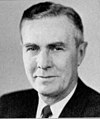His early construction training was with a firm that specialized in the fields of waterworks, dams, sewage treatment plants, roads and bridges.
From the early thirties, he progressed through various posts to where he was appointed Superintendent of Public Works for New York State in October 1948.
In 1950 he became Chairman of the New York State Thruway Authority. Overall construction costs for New York State in 1954 reached $928.5 million.
Rex Marion Whitton 1961–1966

When Rex Marion Whitton retired as Federal Highway Administrator on December 30, 1966, he left behind a career of public service that almost spanned the entire history of modern highway construction in the United States.
He had completed more than 46 years of continuous highway work, of which 40 were spent in his native State of Missouri.
Mr. Whitton rose through the ranks, from a member of a highway survey crew in 1920 to Chief Engineer for the State of Missouri in 1951.
Other posts held by Mr. Whitton included that of assistant resident engineer, resident engineer, chief of survey party, plans designer, assistant district engineer, district engineer, and engineer of maintenance.
During his tenure as Federal Highway Administrator, the Bureau of Public Roads was revised to increase operational efficiency and instill new confidence.
In 1960 he was named one of the top 10 public works men of the year by the American Public Works Association in cooperation with Kiwanis International.
He also was president of the American Association of State Highway Officials (AASHO) 1955–56.
Lowell K. Bridwell 1967–1969

Lowell K. Bridwell, former journalist, acquired a reputation through the years as an authority on highway transportation.
Mr. Bridwell made his first impact on the highway program as a journalist.
A correspondent for the Associated Press and the Ohio State Journal from 1946 to 1950, he became associated with Scripps-Howard News- papers in 1950. He joined the Washington Bureau of Scripps-Howard in 1958 as their top writer on highways.
From this vantage point he set up close liaison with both government and industry. He became well-known as an individual who was exceptionally well versed in the technical aspects of highway administration, finance and construction.
As a representative for Scripps-Howard, Mr. Bridwell participated in many local and national highway meetings. These included numerous conclaves of State highway officials as well as leading trade associations.
He assumed the helm of an expanded and reoriented Federal Highway Administration in 1967 in the new U.S. Department of Transportation.
Mr. Bridwell was responsible for administering a $4.4 billion highway program. This figure dwarfed everything else in the Department of Transportation’s $6.6 billion budget.
194
